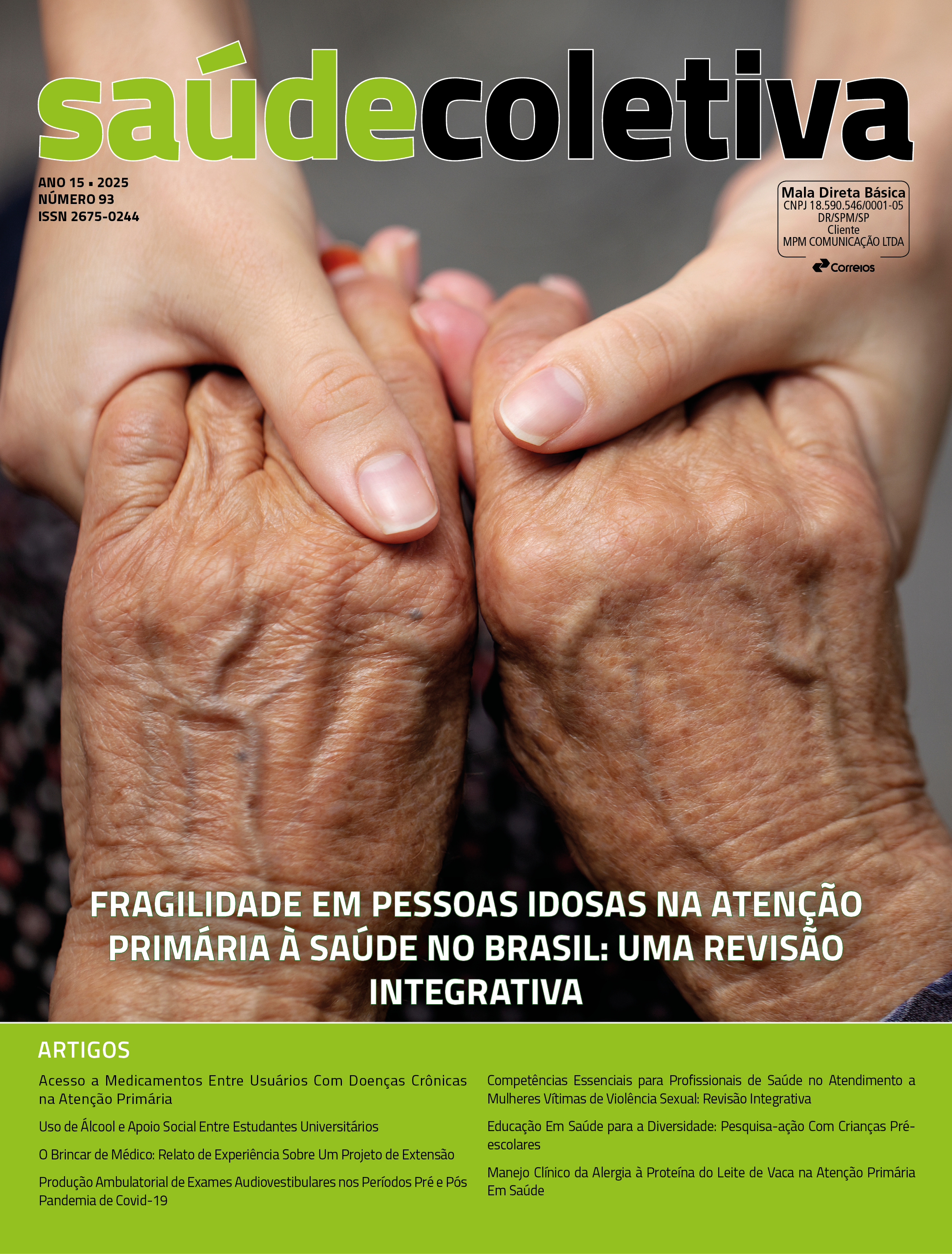Implemented Improvement: Medication Error Prevention
DOI:
https://doi.org/10.36489/saudecoletiva.2025v15i93p14546-14555Keywords:
HIV, Prevention, Medication error, AntiretroviralsAbstract
Medication errors are, above all, preventable events. The vast supply of antiretrovirals3 with complex names and similar vials is a concern regarding the accuracy of dispensing and using the cocktail. Objective: to describe the contributions of the strategy to prevent errors in dispensing antiretroviral drugs for HIV-positive individuals in nursing work. Method: this is an experience report on the organization and dispensing of antiretrovirals for 47 HIV-positive patients in the STI/HIV/AIDS sector of Prudentópolis/PR. Results and Discussion: In order to minimize the risk of errors and streamline the service, a color and letter system was organized to correlate the cocktails and patients, and patient listening was intensified. The medications are delivered monthly/bimonthly from the SAE of Guarapuava/PR. After checking, they are separated into opaque packages and labeled with the patient's first name in the same standardized color as the cocktail used. Ex: (3 in 1 = A – red); (Tenoforir/Lamivudine + Dolutegravir = B – green), etc. Conclusion/Final Considerations: After identifying the risk of errors, color and letter identification systems were applied, making organization faster and dispensing safer, and also making it easier for patients to recognize. Listening to patients was also intensified. Proving that the nursing profession can make a difference in the effectiveness of antiretroviral treatment results.
References
Barboza TC, Guimarães RA, Gimenes FRE, Silva AEB de C. Retrospective study of immunization errors reported in an online Information System. Revista latino- americana de enfermagem, v. 28, p. e3303, 2020.
National Coordinating Council for Medication Error Reporting and Prevention. Medication error definition. 2025. Disponível em: <https://www.nccmerp.org/about- medication-errors>.
Stacanelli IC, Maia MLR, Andrade MC, Paula Júnior W de. Evolução histórica da terapia antirretroviral na infecção pelo HIV no Brasil. Unimontes Científica, Montes Claros (MG), Brasil, v. 26, n. 1, p. 1-33, jan/jun. 2024;
ALMEIDA, E. OMS chama atenção para risco de resistência a medicamentos para HIV. UNAIDS Brasil - Website institucional do Programa Conjunto das Nações Unidas sobre HIV/AIDS (UNAIDS) no Brasil UNAIDS. Brasil, 20 jul. 2017. Disponível em:
<https://unaids.org.br/2017/07/oms-atencao-ameaca-resistencia-medicamentos-hiv/>.
FIOCRUZ. Monitoramento da resistência do HIV a medicamentos. Disponível em: <https://www.ioc.fiocruz.br/noticias/monitoramento-da-resistencia-do-hiv- medicamentos>.
Besen CB, de Souza Netto M, Da Ros MA, da Silva FW, da Silva CG, Pires MF. A Estratégia Saúde da Família como Objeto de Educação em Saúde. Saúde e Sociedade v.16, n.1, p.57-68, jan-abr 2007 5 [Internet]. Scielo.br. Saúde e Sociedade; jan- abr 2007. Disponível em: https://www.scielo.br/j/sausoc/a/RjFgLQMfk74GtQ6GCmkqRqK/?format=pdf&lang=ptBES
Dosse C, Cesarino CB, Martin JFV, Castedo MCA. Factors associated to patients’ noncompliance with hypertension treatment. Rev Lat Am Enfermagem [Internet]. 2009 17(2):201–6. Disponível em: https://www.scielo.br/j/rlae/a/4RL5JSGBwgqZjdCkBWz7nYy/?format=html&lang=es
Moraes RG. Dificuldade de aderência aos tratamentos por pacientes analfabetos do programa Hiperdia: projeto de intervenção em uma Unidade Básica de Saúde de Viana - ES [Internet]. Gov.br. Março de 2023 Disponível em:
<https://ares.unasus.gov.br/acervo/html/ARES/28019/1/Renan_Gottardi_Moraes.pdf>. Acesso em: 25 jan. 2025.
Velame KT, Silva R de S da, Cerutti Junior C. Factors related to adherence to antiretroviral treatment in a specialized care facility. Rev Assoc Med Bras [Internet]. 2020 66(3):290–5. Disponível em: https://www.scielo.br/j/ramb/a/73hyBNGLxS5pfFq4WdjBk8S/?lang=en
Word Helath Organization (WHO). Global Patient Safety Action Plan 2021- 2030 [Internet]. Who.int. World Health Organization; 2021. Disponível em: https://www.who.int/publications/i/item/9789240032705
Alimova G. Pharmacovigilance - Delta PV, redefining value-driven drug safety services [Internet]. Delta PV. 2024 [citado 25 de janeiro de 2025]. Disponível em: https://deltapv.com/services/pharmacovigilance/?gad_source=1&gclid=CjwKCAiAtNK8BhB BEiwA8wVt93569EFo8teI1Towbb0C8fM8aJZzmNdNt2i90iXd2OB8z- yEPB4etxoC4F4QAvD_BwE
Berman A. Reducing medication errors through naming, labeling, and packaging. J Med Syst [Internet]. 2004;28(1):9–29. Disponível em: http://dx.doi.org/10.1023/b:joms.0000021518.60670.10
Miranda M de MF, Oliveira DR de, Quirino G da S, Oliveira CJ de, Pereira MLD, Cavalcante EGR. Adherence to antiretroviral therapy by adults living with HIV/aids: a cross-sectional study. Rev Bras Enferm [Internet]. 2021;75(2):e20210019. Disponível em: https://www.scielo.br/j/reben/a/Vdp8cq6ZWLtmVDFny5hSDts/?lang=en
Horvatich G. 5,6 milhões de unidades: Saúde distribui novo medicamento para pacientes com HIV ou aids [Internet]. Conselho Federal de Farmácia. 2024. Disponível em: https://site.cff.org.br/noticia/Noticias-gerais/10/01/2024/5-6-milhoes-de-unidades- saude-distribui-novo-medicamento-para-pacientes-com-hiv-ou-aids







